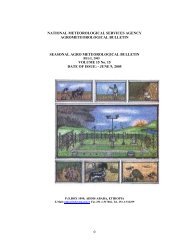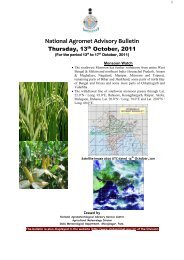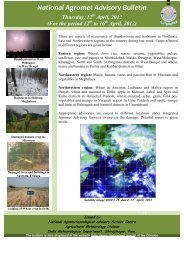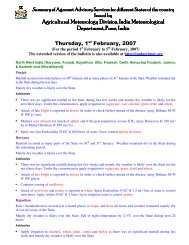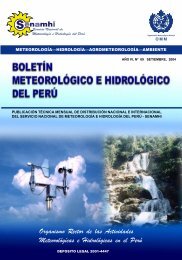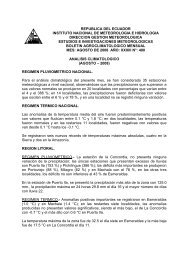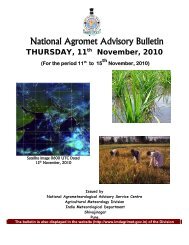national meteorological agency agrometeorological bulletin
national meteorological agency agrometeorological bulletin
national meteorological agency agrometeorological bulletin
You also want an ePaper? Increase the reach of your titles
YUMPU automatically turns print PDFs into web optimized ePapers that Google loves.
NATIONAL METEOROLOGICAL AGENCY AGROMETEOROLOGICAL BULLETINSEASONAL AGROMETEOROLOGICAL BULLETINBELG 2009VOLUME 19 No. 15DATE OF ISSUE: - JUNE 10, 2009P.O.BOX 1090, ADDIS ABABA, ETHIOPIAE.Mail: nmsa@ethionet.et Fax: 251-11-6625292, Tel. 251-11-6615779
FORE WARDThis Agro met Bulletin is prepared and disseminated by the National Meteorological Agency(NMA). The aim is to provide those sectors of the community involved in Agriculture and relateddisciplines with the current weather situation in relation to known agricultural practices.The information contained in the <strong>bulletin</strong>, if judiciously utilized, are believed to assist planners,decision makers and the farmers at large, through an appropriate media, in minimizing risks,increase efficiency, maximize yield. On the other hand, it is vital tool in monitoring crop/ weatherconditions during the growing seasons, to be able to make more realistic assessment of the annualcrop production before harvest.The Agency disseminates ten daily, monthly and seasonal weather reports in which all thenecessary current information’s relevant to agriculture are compiled.We are of the opinion that careful and continuous use of this <strong>bulletin</strong> can benefit to raise ones agroclimate consciousness for improving agriculture-oriented practices. Meanwhile, your commentsand constructive suggestions are highly appreciated to make the objective of this <strong>bulletin</strong> a success.Director GeneralNMAP.O.Box 1090Tel: 011661-57-79FAX 00251-11-6625292E-mail nmsa@ethionet.etAddis AbabaWeb site: - http://www.ethiomet.gov.ethttp://www.Ethiopia.ranet.net
AህፅሮትE.ኤ.A በልግ 2009በመደበኛ ሁኔታ መካከለኛው የሰሜን ከፍተኛ ቦታዎች የምስራቅ ከፍተኛ ቦታዎች ከፊልየመካከለኛው የደቡብ ምEራብና የደቡብ Iትዮጵያ በልግ Aብቃይ በመባል ይታወቃሉ። በሰሜን"በሰሜን ምሥራቅና በምስራቅ ከAመታዊው ምርት የበልግ ምርት AስተዋፅO ከ5-30% በደቡብናደቡብ ምEራብ ከ30-60% ይደርሳል። ሰሜን ሸዋ" ምስራቅና ምEራብ ሐረርጌ" Aርሲ" ባሌ"ሰሜንና ደቡብ ወሎ" ቦረናና የደቡብ ብሔር ብሔረሰቦችና ህዝቦች ክልል (ከምባታ" ሀድያ"ወላይታ" ጉለኔ" ከፋና ቤንች) የማሣ ዝግጅትና የዘር ጊዜ የሚጀምሩት ከታህሳስ Eስከ የካቲት ባለውጊዜ ውስጥ ነው። በተጨማሪም ወቅቱ የደቡብና ደቡብ ምስራቅ Aከባቢዎች ለግጦሽ ሣርና ውሃAቅርቦት የሚሆን ውሃ የሚያከማቹበት ቦታ ነው።E.ኤ.A በየካቲት ወር 2009 የነበረው የዝናብ መጠን Eንብዛም የተጠናከረ መልክባይኖረውም በምEራብ የሀገሪቱ Aጋማሽ ላይ ግን ዝናቡ ተከታታይነት ያለውና በመጠንና በቦታሽፋን ረገድ ጥሩ ገፅታ Eንደነበረው ተስተውሏል። ይህም ለበልግ Eርሻ Eንቅስቃሴ ማለትም ለዘርናለማሳ ዝግጅት Eንዲሁም ለቋሚ ተክሎችና ለAርብቶ Aደሩና ለከፊል Aርብቶ Aደሩ ለመጠጥ ውሃAቅርቦት Eና ለግጦሽ ሳር ልምላሜ Aዎንታዊ ተፅEኖ የነበረው ሲሆን ይህም ለበልግ AብቃይAካባቢዎች ለወቅቱ ዝናብ መደበኛውን ፈር ተክትሎ መጣሉ ለበልጉ Eርሻ Eንቅስቃሴ በጎ ጎንመኖሩ ከመረጃ ዘጋቢ ጣቢያዎቻችን ለማወቅ ተችሏል። በAጠቃላይ መልኩ ሲታይ የፌብሪዋሪዝናብ በAብዛኛው Aማራ Oሮሚያ Eና የደቡብ ብሔር ብሔረሰቦችና ህዝቦች ክልል ለበርካታ ቀናትዝናብ ሲያገኙ የቆዩ ሲሆን በሰሜን ምስራቅ Aማራ በምEራብ Oሮሚያና Aጎራባች የደቡብ ብሔርብሔረሰቦች ክልል Aንዳንድ ቦታዎች ላይ ከባድ ዝናብ የተመዘገበ መሆኑን ከዝናብ መረጃዎችለማወቅ ተችሏል ሆኖም ግን በAዝርEትና በሰው ላይ ያደረሰው ጉዳት Aልነበረም። በወሩ መጨረሻቀናት ውስጥም ከደቡብ ምEራብ Eስከ ሰሜን ምስራቅ የሚገኙትን የበልግ Aብቃይ Aካባቢዎችየተስፋፋ ሲሆን ይህም ለበልጉ Eርሻ Eንቅስቃሴ በጎ ጎን Eንደነበረው ታውቋል። ከዚህም ሌላ በወሩውስጥ የተሻለ የዝናብ መጠን ስርጭት በምEራብ Oሮሚያ በደቡብ ብሔር ብሔረሰቦች ክልልበምስራቅ Aማራ Aካባቢዎች ሰሆኑ የዝናብ መጠንና ስርጭት ይነስ Eንጂ የደቡብ Eና የሰሜን ሶማሌየምስራቅ Oሮሚያና የምEራብ Aማራ Aካባቢዎችም ለተወሰነ ቀናት ዝናብ Aግኝተዋል ይህምለበልጉ ወቅት የEርሻ ሥራ Eንቅስቃሴ ለAርብቶ Aደሩና ለከፊል Aርብቶ Aደሩ በጎ ጎን Eንደነበረውተስተውሏል።በየካቲት ወር የነበረውን የEርጥበት ካርታ ጠቋሚ ስንመለከት በAንዳንድ የደቡብብሔር ብሔረሰቦች ክልል" ምስራቃዊ Aማራ ኪስ ቦታዎች Eንዲሁም መካከለኛው Oሮሚያ የተወሰኑቦታዎች በስተቀር Aብዛኛው የሀገሪቱ ክፍሎች ደረቅና በጣም ደረቅ (dry to very dry) ሁኔታነበር የተስተዋለው።E.ኤ.A መጋቢት ወር 2009 በተለይ በወሩ በመጀመሪያው Aጋማሽ በAብዛኞቹ በልግAብቃይ Aካባቢዎች ደረቅና ፀሐያማ የAየር ሁኔታ ነበር የተዘወተረው በመሆኑም በተለይ ቀደምብለው የዘር ጊዜያቸውን ባደረጉት Aካባቢዎች በAዝርEት ላይ የውሃ Eጥረት ያስከተለ ነበር።ይሁንና ከወሩ ሁለተኛ Aጋማሽ ጀምሮ በመጠጥም ሆነ በስርጭት በተለይ በደቡብ ምEራብ EናበምEራብ ሰሜን ምስራቅ Eና በምስራቅ የሀገሪቱ ክፍሎች Eየታየ የመጣው መደበኛና ከመደበኛበላይ ዝናብ በተለያየ የEድገት ደረጃ ላይ ላሉ የበልግ ሰብሎች Eንዲሁም ለቋሚ ሰብሎችና በሃገሪቱዝቅተኛ ቦታዎች ለሚገኙ ለAርብቶ Aደሩና ለከፊል Aርብቶ Aደሩ ለግጦሽ ሳርና ለመጠጥ ውሃAቅርቦት በጎ ጎን Eንደነበረው ይታመናል። በተጨማሪም በሃገሪቱ ዝቅተኛ ቦታዎች በተለይም ሰሜንምስራቅ" የደቡብ ምስራቅ ዝቅተኛ ቦታዎች የተገኘው ከፍተኛ ሙቀት የAካባቢውን የትነት መጠን
Eንደሚጨምረው ይታመናል። የመጋቢት ወር የEርጥበት ጠቋሚ ካርታ Eንደሚያሳየው ደቡብናደቡብ ምEራብ" የምEራብና የምስራቅ Oሮሚያ ኪስ ቦታዎች Eንዲሁም የምስራቅና ሰሜን Aማራየተወሰኑ ቦታዎች ከEርጥበት በጣም Eርጥበት (moist to humid) Aግኝተዋል። ይህም ሁኔታበተለያየ የEድገት ደረጃ ላይ ለሚገኙት የበልግ ሰብሎቸ Eና ለቋሚ ሰብሎች Eንዲሁም ለAርብቶAደሩና ከፊል Aርብቶ Aደሩ ለግጦሽና ለመጠጥ ውሃ Aቅርቦት ጠቀሜታው የጎላ ነበር በሌላም በኩልበደቡብ ትግራይ በምስራቅ Aማራ የተወሰኑ ቦታዎች በመካከለኛው Iትዮጵያ Eንደዚሁም በተቀሩትየሀገሪቱ ክፍሎች ቀደም ባለው ወር የEርጥበት Eጥረት የነበረው ሁኔታ Aባብሶባቸዋል። በEርሻውEንቅስቃሴ ላይም Aሉታዊ ተፅEኖ Aሳድሯል።E.ኤ.A በሚያዝያ ወር 2009 በAብዛኛው Oሮሚያ የደቡብ ብሔር ብሔረሰቦችና ሕዝቦችክልል ጋምቤላ የምስራቅ Iትዮጵያ Aካባቢዎችና የምስራቅ Aማራ ኪስ ቦታዎች በመጠን ከ50-296ሚ.ሜ ከ10 Eስከ 22 ቀናት የነበረ በመሆኑ ለEርሻ ሥራ Eንቅስቃሴ ከፍተኛ ጠቀሜታ የነበረውሲሆን በAብዛኛው ምስራቅ Aማራ መካከለኛውና ምስራቅ Iትዮጵያ ቤንሻንጉል ጉሙዝ ደቡባዊAጋማሽ በመጠን ከ25-50 ሚ.ሜ በስርጭት ከ5-10 ቀናት ዝናብ በማግኘታቸው በAጠቃላይለEርሻና Eርሻ ሥራ Eንቅስቃሴ በመጠኑም ቢሆን ጠቀሜታ ነበረው። የሚያዚያ ወር Eርጥበትጠቋሚ ካርታ Eንደሚያመለክተው የበልግ ወቅት ተጠቃሚና የረጅም ጊዜ ቋሚ ሰብሎች የሚያበቅሉAካባቢዎች ባብዛኛው Oሮሚያ" የደቡብ ብሔር ብሔረሰቦች ጋምቤላ የምስራቅ Aማራ ኪስ ቦታወችEና የምስራቅ Iትዮጵያ የተወሰኑ ቦታዎች ላይ ከEርጥበት Eስከ በጣም Eርጥበት (moist tohumid) የEርጥበት ሁኔታ ተስተውሎባቸዋል። ይህም ሁኔታ ለበልግ ሰብሎች" ለቋሚ ሰብሎችEንዲሁም የረጅም ጊዜ ሰብሎችን ለመዝራት Aዎንታዊ ተፅEኖ ነበረው። Eንዲሁም በሚያዚያየተገኘው Eርጥበት ለAርብቶ Aደሩም Aካባቢ ጠቀሜታው የጎላ ነበር።በሌላም በኩል ሰሜናዊAጋማሽ የሀገሪቱ ክፍሎች ትግራይ Aብዛኛው Aማራ ቤንሻንጉል ጉሙዝ Aፋር Eና ሱማሌ ከደረቅEስከ በጣም ደረቅ (dry to very dry) ሁኔታ ተስተውሎባቸዋል። ይህም ሁኔታ በመካሄድ ላይላለው የEርሻ Eንቅስቃሴ Aሉታዊ ተፅEኖ Aሳድሯል። በሌላም በኩል በደቡብ በደቡብ ምEራብበምEራብ Eና በምስራቅ የሀገሪቱ ክፍሎች የEፅዋት ሽፋን ተሻሽሏል።ከግብርናና ገጠር ልማት ሚኒስቴር በሚያዚያ ወር የፊልድ መረጃ በተለያዩ የሀገሪቱ ክፍሎችላይ ሰብሎች ያሉበትን የEድገት ደረጃ Eንደሚያሳየው ከመዝራዘት Eና ቡቃያ Eስከ ብቅለት(በደቡብ ህዝቦች Eና Oሮሚያ)" ከብቅለት Eስከ Eድገት (በደቡብ ሕዝቦች" በOሮሚያ Eና በAማራ)Eንዲሁም ከEድገት Eስከ ማበብ (በደቡብ ሕዝቦች) Eንዲሁም የመኽር ወቅት የረጅም ጊዜ ሰብሎችበOሮሚያ" በAማራ በትግራይና በድሬደዋ Aስተዳደር በAብዛኛው ስፍራዎቻቸው በመዘራት Eናበብቅለት ደረጃ ላይ Eንደሚገኝ ተገልጿል። በሌላም በኩል በAንዳንድ የደቡብ ትግራይ" ሰሜን ሸዋOሮሚያ ዞን Eንድሁም በደቡብ ህዝቦች በEርጥበት Eጥረት ምክንያት የሰብሎች መጠውለግናመጥፋት ምክንያት ማሳ ተገልብጦ Eንደገና ተዘርቷል።E.ኤ.A በግንቦት ወር 2009 የበልግ ወቅት የመጨረሻ ወር በመሆኑ የበልግ ዝናብ ሰጪየAየር ሁኔታ ክስተቶች ቀስ በቀስ በሀገሪቱ የበልግ ዝናብ ተጠቃሚ በሆኑት ስፍራዎች ላይየሚዳከሙበት ጊዜ ነው። በዚህ የሜይ የመጀመሪያ Aስር ቀናት የዝናቡ ስርጭትና መጠን በደቡብናበደቡብ ምEራብ የሀገሪቱ Aካባቢዎች የተሻለ ገፅታ የነበረው ሲሆን Aልፎ Aልፎ በጥቂት የምስራቅናየሰሜን ምስራቅ Eንዲሁም የምEራብ የሀገሪቱ Aካባቢዎች ውስን ቦታዎች ላይ ዝናብ ነበር።ይህምሁኔታ ለረጅም ጊዜ ሰብሎች" ለቋሚ ሰብሎች" በተለያዩ Eድገት ደረጃ ላይ ላሉ የበልግ ሰብሎች Eናለመኽር የማሳ ዝግጅት ጠቀሜታ ሲኖረው በወሩ Aጋማሽ Aካባቢ ባሉት የወሩ ሁለተኛ Aስር ቀናትመጀመሪያ ላይ ዝናቡ የተጠናከረ መልክ የነበረው ከመሆኑም ባሻገር የሶማሌ ደቡባዊ Aካባቢዎችላይ ተስፋፍቶ ተስተውሏል። በመሆኑም በመጠኑ የተጠናከረ ዝናብ በደቡባዊ የሀገሪቱ AጋማሽAንዳንድ Aካባቢዎች ነበር። ይህም ሁኔታ ለመኽር ወቅት ለማሳ ዝግጅት" ለAጠቃላይ የEርሻEንቅስቃሴ Eና ለAርብቶ Aደሩና ከፊል Aርብቶ Aደሩ ለግጦሽ ሳር Eና ለመጠጥ ውሃ AቅርቦትAመቺ ሁኔታ የነበረው ሲሆን በመቀጠል ከወሩ Aጋማሽ በኋላ ባሉት የመጨረሻዎቹ Aስር ቀናት
BELG 2009SUMMARYNormally central parts of northern highlands, eastern highlands, parts of central, southwesternand southern Ethiopia are known as Belg growing areas .The contribution of Belg rainfall isranging from 5-30% over north, northeastern, and eastern highlands, where as 30-60% oversouth and southwestern parts of the country from annual total crop production of the areas. NorthShewa, East and West Hararge, Arsi, Bale, north and south Wello, Borena and SNNPR(Kembata, Hadiya and Wolaita, Gurage, Keffa and Bench) start their land preparation andsowing activities during December to February. It is the time for water harvesting over pastoraland agro pastoral areas of southern and southeastern Ethiopia.During the month of February 2009, the rainfall activities over most Belg growing areas of thecountry favored land preparation. While over western and southwestern parts of Belg growingareas the rainfall activities were conducive for Belg agricultural activities as well as for perennialcrops. Belg rain-benefiting areas of southwestern and northeastern portions of the countryrecorded sufficient rain, which favored for Belg agricultural activities as well as availability ofdrinking water and pasture. Although, limited amount of rainfall was observed over parts ofsouthern and northern Somalia, eastern Oromiya and western Amhara the rainfall activityfavored Belg agricultural activities, availability of pasture and drinking water. The moisturestatus for the month of February indicated Moist to humid moisture over some parts ofsouthwestern SNNPR, pocket areas of eastern Amhara and central Oromia. this situation wasconducive for Belg land preparation for area which sowing activity start earlier.During the month of March 2009, sunny and dry weather condition has been observed during thefirst half of the month, the situation might have negative impact on areas where Belg agriculturalactivities start earlier. During the second half of march the seasonal rainfall activities intensifiedin terms of distribution and amount due to the intensification of rain bearing system, particularlysouth western, western, north eastern and eastern parts of the country which received normal toabove normal rainfall. Besides the widely observed distributed rainfall situation might havepositive contribution for the development of Belg crops which were at different growing stages,perennial crops and availability of pasture and drinking water over pastoral and agro pastoralareas of the country. On the other hand, the observed extreme maximum temperature overlowland parts of the country particularly over northwestern, southeastern and northeasternlowland parts of the country might have increased the rate evapo-transpiration. During the monthof March southern and south western parts of the country, pocket areas of western and easternOromia and eastern and northern Amhara exhibited moist to humid moisture status. Thiscondition might have positive contribution on the development of Belg crops and perennial cropswhich were at different growing stages, and availability of pasture and drinking water overpastoral and agro pastoral areas of the country. On the other hand the observed dry and very drymoisture status exacerbate the deficient condition persisted during the month of February whichaffected the Belg’s agricultural activity in southern Tigray, some pats of eastern Amhara andcentral Ethiopia.During the month of April 2009, the rainfall activity covered much of Belg growing areas. Therainfall amount and distribution was better over much of Oromia, SNNPR, Gambela, some partsof eastern Ethiopia and pocket areas of eastern Amahara within the range of 50-296 mm for 10 to22 rainy days in the month. The amount of rainfall was heavy over western and southwestern
parts of the country. Arjo, Gore, Bedelle, Jinka, Amman, Masha and Bati recorded 73.2, 60.0,68.4, 52.0, 50.0 and 45.8 mm of rainfall in one rainy day respectively. The rainfall activity ofApril 2009 was normal to above normal over western Oromia and surrounding Benishangul -Gumz Gambela, western half of SNNPR and western Amhara. The situation was conducive forthe on going agricultural activities, perennial crops and availability of pasture, water. While therest part of the country experienced below normal rainfall which had negative impact onagriculture activities and general vegetation conditions. During the month of April Moist tohumid moisture status has been covered in most Belg and long cycle crops growing areas overmuch of Oromia, SNNPR, Gambela, some parts of eastern Ethiopia and pocket areas of easternAmahara. The situation helped Belg crops, perennial crops and planting of long cycle crops. Theconditions during April have helped to improve the existing water shortage in pastoral areas aswell. On the other hand northern half the country like Tigray, most of Amhara, B.Gumuze, Afarand Somali experienced dry and very dry moisture condition which had negatively affected theon going agricultural activities and pasture and drinking water. The vegetation cover improvedover southern, south western, western and eastern parts of the country due to the better moistureobtained.Ministry of agriculture and Rural Development filed report stated Phenological status ofcrops during the month of April to be from sowing and germination to seedling stages inSNNPR (Sidama, Gedeo zone, Amaro, Alaba, Basketo special woredas), Oromia (West Arsi,Arsi, Bale East and west Harerge, and Guji zones), From seedling to vegetative stage in SNNPR(Welaita, Hadia, Gamogofa, south Omo zons and Konso special woreda), Oromia (Guji zone),Amhara (north shewa, Oromia, South and North Wollo zone ) and Tigray (Rayaa Azebo,wereda) and From vegetative to flowering stages in SNNPR (Keffa, sheka, bench Maji andDawro zons). Long cycle meher crops are at, sowing, and seedling stages in Oromia region;(Ilubabore, Jimma east and west wellega (Qelem and Horogudru), Borena, Amhara region;(Sowthwest Shewa in North Wollo, North Shewa, south and north Gonder, Weast Gojame andAwi zones), Tigray Region; (Raya Azebo and Afrom Wredas) and Diredawa administration.On the other hand, severer wilting and damage of belg crops, owing to moisture stress, andconsequently replanting is reported from some belg growing area of the country such assouthern zone of Tigray and North shewa zone of Oromia and some parts of SNNPR(Gurage, Kembata Tembaro, Hadia, Sidama Konso zone) and Oromia (Arsi, Guji zone).During the month of May 2009, under normal circumstance the rainfall activity exhibited adecreasing in belg growing areas of the country. However, the first dekad of the month exhibitedbetter rainfall amount and distribution over southern and southwestern and some pocket areas ofeastern, northeastern and western parts of the Country. This situation would have significantcontribution for belg crops which were at different phenological stage, Perennial crops andmeher long cycle crops. Moreover, during the second and third dekad of May southern parts ofthe country including southern Somali and south eastern parts of the country received widedistribution of rainfall. The observed wide distribution of rainfall could have a positivecontribution for belg crops, sowing of long cycle crops like maize and sorghum including pulsecrops like haricot bean and also fevered for pasture and drinking water over the low lands ofpastoral and agro postural area of the country. The analysis of moisture status indicated thatthere was significant increase in moisture condition over most parts of SNNPR, Gambela,Benshangul-Gumuze, Most parts of Oromia and south and eastern Amhara during the month ofMay. The situation favored the general agricultural activities and availability of pasture anddrinking water over southern and south eastern lowlands of the country.
Generally During Belg 2009, both moisture status and water balance analysis shows that theoverall moisture condition during the season was in good shape over southern half of thecountry including most parts of SNNPR, some parts of central, southern and eastern Oromia andmoderate condition was observed over pocket areas of eastern & southern Amhara. Besides thefield report made by MoARD confirmed that, the observed rainfall condition over most parts ofBelg growing area of SNNPR, Oromia and some parts of eastern Amhara was better as comparedto last year. Moreover moist to humid moisture status has been observed in most meher longcycle crops growing area during the month of April and May and the situation favoured for landpreparation and sowing activity. Improvement of pastors conditions over postural areas is moreconfined to the southern, southwestern and eastern low lands of the country.Total crops water requirement for this Belg season is said to be total failure for northern,northeastern & parts of eastern Ethiopia. Moderate to very good WRSI condition is confinedover southern, southwestern, Bale & Arsi zones of Belg growing areas of the country thecondition is comparatively better than that of last year. Moreover, there were no reports on theoccurrence of pest and/or livestock outbreak and fire hazards not reported from any regionduring the season.
Figure.1 Moisture status for February 2009 Figure.2 Moisture status for March 2009Figure.3 Moisture status for April 2009 Figure.4 Moisture status for May 2009Figure.5 Belg growing areas of the country (TheGreen shaded areas)
Fig. 6. Rainfall distribution in mm (21-31 May, 2009)1. WEATHER ASSESSMENT1.1 May 21-31, 20091.1.1 Rainfall Amount (Fig 6)Pocket areas of western and southern Oromia and eastern Benshangul-Gumuz received 50-100 mmrainfall. Gambela, western half of SNNPR and eastern Benshangul-Gumuz, parts of western andpocket area of southern Oromia and pocket area of western Amhara experienced 25-50 mmrainfall. Western half of Benshangul-Gumuz, parts of western, central and southern Oromia andsouthwestern Amhara, margin of eastern SNNPR and pocket area of northern Somali exhibited 5-25 mm rainfall. The rest parts of the country received little or no rainfall.
Fig. 7 Percent of normal (21-31 May 2009)1.1.2 Rainfall Anomaly (Fig 7)Explanatory notes for the Legend:< 50-Much below normal50-75%-Below normal75-125%- Normal> 125% - Above normalWestern half of SNNPR, pocket areas of southern and eastern Oromia and eastern Benshangul-Gumuz received normal to above normal rainfall. The rest parts of the country exhibited belownormal to much below normal rainfall
Fig. 8 Rainfall Distribution in mm for the month of May 20091.2 May 20091.2.1 Rainfall Amount (Fig. 8)Some parts of western Oromia few areas of SNNPR and Benishangul –Gumz and pocket areas ofAmhara exhibited 300-400mm of rainfall. Some parts of western Oromia, of SNNPR, ofBenishangul –Gumuz, of central Amhara, and few areas of central and pocket areas of easternOromia received 200-300mm of rainfall. Much of Amhara, Gambela, some parts of SNNPR,Benishangul-Gumuz and central and eastern Oromia experienced100-200mm of rainfall. Mucheastern, southern central Oromia, south-western parts of SNNPR, much of Benishangul-Gumuz,some parts of Amhara, Tigray, and Somali exhibited 50-100mm of rainfall. Much of Tigray,Somali, eastern parts of Amhara, received 25-50mm of rainfall. While pocket areas of southernOromia and the rest parts of the country exhibited 5-25mm of rainfall.
Fig. 9 Percent of Normal Rainfall for the month of May 2009Explanatory notes for the Legend:< 50 -Much below normal50-75%-Below normal75-125%- Normal> 125% - Above normal1.2.2 Rainfall Anomaly (Fig. 9)Most of SNNPR and Somali, southern half of Gambela and part of southern Oromia receivednormal rainfall. The rest parts of the country experienced below normal and much below normalrainfall.
Fig. 10 Rainfall Distribution in mm for Belg 20091.3 Belg 20091.3.1 Rainfall Amount (Fig. 10)Pocket area of western SNNPR received above 600mm rainfall, western half of SNNPR,eastern half of Gambela and part of western and southern Oromia received 400-600 mm rainfall.Western half of Gambela, western and southern Oromia and margin of western SNNPRexperienced 300-400 mm rainfall. Parts of western Gambela, western and southern Oromia,eastern and northeastern SNNPR and tip of southern Somali exhibited 200-300 mm rainfall. Partsof western, central and eastern Oromia, southeastern Benshangul-Gumuz, northern and westernSomali and part of southern, eastern, and central Amhara received 100-200 mm rainfall. Northernhalf of Benshangul-Gumuze, central Oromia, Much parts of Somali and southern Afar, part ofsouthern and pocket areas of central and western Amhara and some parts of central and southernTigray experienced 50-100 mm rainfall. Most of Tigray, northern tip of Amhara,western andsouthern Afar and northern Somali exhibited 25-50 mm rainfall. Most parts of Afar received 5-25mm rainfall.
Fig. 11 Percent of Normal Rainfall for Belg 2009Explanatory notes for the Legend:< 50 -Much below normal50-75%-Below normal75-125%- Normal> 125% - Above normal1.3.2 Rainfall Anomaly (Fig. 11)Some parts of western Tigray, central and western tip of Amhara, some parts of western andsouthern Oromia, eastern parts of Benshangul-Gumuz, Gambela, western half of SNNPR northerntip of Somali exhibited normal to above normal rainfall. The rest parts of the country experiencedbelow to much below normal rainfall.
1.4 TEMPERATURE ANOMALYMany stations recorded extreme maximum temperature 35 o C and above during the season. Tomention some of them which recorded above 40 o C Humera, Metema, Gambela, Mankush ,Gewane,Dubti, Semera, Mille, Aisha, Elidar and Assayta recorded extreme maximum temperature as high as44.7, 43, 43.5, 42.5, 40.0, 42, 41.5, 41.0, 41.0, 44.5, and 40.6 respectively during the season. Thiscondition might affect the normal growth and development of plants as well as living livestock overthe aforementioned areas.2. AGROMETEOROLOGICAL CONDTIONS AND IMPACT ON AGRICULTURE2.1 VEGETATION CONDITION AND IMPACT ON AGRICULTURE DURINGBELG 2009Generally During Belg 2009, both moisture status and water balance analysis shows that theoverall moisture condition during the season was in good shape over southern half of thecountry including most parts of SNNPR, some parts of central, southern and eastern Oromia andmoderate condition was observed over pocket areas of eastern & southern Amhara. Besides thefield report made by MoARD confirmed that, the observed rainfall condition over most parts ofBelg growing area of SNNPR, Oromia and some parts of eastern Amhara was better as comparedto last year. Moreover moist to humid moisture status has been observed in most meher longcycle crops growing area during the month of April and May and the situation favoured for landpreparation and sowing activity. Improvement of pastors conditions over postural areas is moreconfined to the southern, southwestern and eastern low lands of the country.Total crops water requirement for this Belg season is said to be total failure for northern,northeastern & parts of eastern Ethiopia. Moderate to very good WRSI condition is confinedover southern, southwestern, Bale & Arsi zones of Belg growing areas of the country thecondition is comparatively better than that of last year. Moreover, there were no reports on theoccurrence of pest and/or livestock outbreak and fire hazards not reported from any regionduring the season.
2.2 EXPECTED WEATHER IMPACTS ON AGRICULTURE DURING THE COMINGKIREMT SEASONIn normal condition most parts of the highlands including southern and eastern midlandsare known as Kiremt growing areas. The Belg season rainfall particularly the rainfall amountand distribution observed during April and May has significant impact on the performance oflong cycle crop like Maiz and Sorghum which achieve maturity during the Bega season.Their contribution is about 35% of the total meher production.Western Ethiopia will experience a probability of normal to above normal availability ofmoisture which is Conducive for Meher agricultural activities and availabilities of pastureand drinking water. Northeastern and northwestern, central and eastern Ethiopia willexperience a probability of moisture deficiency condition which which will cause negativeimpact on Meher agricultural activities, perennial crops and availability of pastor & waterover pastoral and agro pastoral areas thus we advice cautiously taken care off appropriateaction (water harvest, conservation and short varieties crops) to alleviate the expected risk.Parts of southern Ethiopia and southern half of Somali expected to experience probability ofnormal to above normal condition which is conducive for availabilities of pasture and water.The analyzed moisture status of all selected analogue years expected to favor Meheragricultural activities over Meher growing areas of the country and availability of pastureand water over pastoral and agro-pastoral areas of the Country. Occasional heavy rainfallactivity over some highland areas, can lead to water logging over low-lying areascharacterized with verity soil type of soil. Thus, farmers advised to make small water channelon their plot of land and advised to strengthen soil conservation structure, which were inplace over sloppy and mountainous places, where agriculture farming will take place.
Table 1. Climatic and Agro-Climatic elements of different stations for the month of May 2009Amount Percent of ETo Monthly MoistureStations Region of rainfall Normal Normal mm/day ETo statusAdigrat NA NA NA NA NA NAAdawa NA NA NA NA NA NAHumera TIGRAI 0.0 NA 0.0 5.86 175.8 VDMekele 0.0 30.1 0.0 6.78 203.4 VDMaichewNA NA NA NA NA NASenkata 26.7 62.3 42.9 6.35 190.5 DDubti 0.0 13.5 0.0 6.74 202.2 VDSemera AFAR 1.0 62.3 1.6 6.3 189 VDA. Ketema 13.6 70.9 19.2 6.3 189 DAyehu NA NA NA NA NA NAAykel 41.8 179.3 23.3 6.18 185.4 DBahirdar 7.5 84.7 8.9 5.52 165.6 VDBati 2.0 62.9 3.2 4.91 147.3 VDCombolcha 6.4 58.8 10.9 4.74 142.2 VDChefa NA NA NA NA NA NAD.Birhan 14.9 34.9 42.7 4.99 149.7 DD.Markos 14.4 94.9 15.2 5.24 157.2 DD.Tabor 28.2 92 30.7 4.98 149.4 DDangila NA NA NA NA NA NAEnwaryAMHARA0 51.6 0.0 6.36 190.8 VDGonder 8.9 88.8 10.0 5.64 169.2 DM.Meda 18.2 35.9 50.7 5.11 153.3 DMajete 50.5 85.2 59.3 5.24 157.2 MDMetema 64.1 75.1 85.4 5.88 176.4 MDLalibela 2.3 34.6 6.6 5.16 154.8 VDMotta NA NA NA NA NA NAS. Gebeya14.6 48.8 29.9 5.13 153.9 DAbomsa 28.7 71.4 40.2 5.79 173.7 DAlemaya 90 103.9 86.6 3.86 115.8 MAlge 80 211.6 37.8 4.23 126.9 MAmbo 47.5 78.3 60.7 4.91 147.3 MDArjo 141.3 249.3 56.7 4.4 132 MBedelle 69.2 226.1 30.6 NA NA NABegi 41.9 230 18.2 4.07 122.1 MDD.Mena 185.8 190 97.8 4.01 120.3 HD.Zeit 17.5 51.6 33.9 5.52 165.6 DFitche 16.4 55.8 29.4 4.64 139.2 DEjaji NA NA NA NA NA NAGelemso NA NA NA NA NA NAGimbi 28.5 183.4 15.5 4.83 144.9 DOROMIYAGinir 113.1 211.3 53.5 4.18 125.4 MGore 85.1 240.2 35.4 3.88 116.4 MH. Mariam 28.5 183.4 15.5 4.83 144.9 DJimma 113.1 211.3 53.5 4.18 125.4 MK.Mengist 85.1 240.2 35.4 3.88 116.4 MKachisa 155.1 187.6 82.7 3.14 94.2 H
Limugenet 67.8 220.1 30.8 3.31 99.3 DMieso 16.5 128.3 12.9 4.9 147 DMetehara 47 114.5 41.0 3.46 103.8 MDMoyale 92.3 214.1 43.1 4.17 125.1 MNazreth 15.8 58.6 27.0 5.78 173.4 DNeghele 14.1 35.4 39.8 5.95 178.5 DNedjo NA NA NA NA NA NANekemte 22.1 56.7 39.0 6.59 197.7 DNuraera 131.9 147.2 89.6 4.08 122.4 MRobe (Bale) 72 186.7 38.6 4.08 122.4 MSekoru 107.2 237.8 45.1 4.08 122.4 MShambu NA NA NA NA NA NAWolliso 44.4 93.4 47.5 4.18 125.4 MDZeway NA NA NA NA NA NAGode 42.1 53.4 78.8 5.95 178.5 DJijiga SOMALI 90.7 103.1 88.0 4.84 145.2 MA.Minch 100.1 153.2 65.3 4.15 124.5 MAwassa 62.4 123.3 50.6 4.33 129.9 MBui NA NA NA NA NA NADilla SNNPR NA NA NA NA NA NAHosaina 107.4 131 82.0 3.97 119.1 MJinka 152 158 96.2 3.94 118.2 HKonso 93 98.6 94.3 4.19 125.7 MM.Abay NA NA NA NA NA NASawla132 167.9 78.6 3.76 112.8 HAssosa NA NA NA NA NA NAChagni 102.3 146.3 69.9 4.62 138.6 MBullenB/GUMUZNA NA NA NA NA NAPawe42.1 120.9 34.8 5.09 152.7 MDGambela Gambela 136.9 160.4 85.3 4.15 124.5 HA.A. Bole. 38.1 78.5 48.5 5.64 169.2 MDA.A. Obs A.A NA NA NA NA NA NADiredawa D.D 24.0 46.8 51.3 5.8 174 DHarar Harai NA NA NA NA NA NALegendVD Very Dry < 0.1D Dry 0.1 - 0.25MD Moderately Dry 0.25 - 0.5M Moist 0.5 - 1H Humid >1Explanatory NoteEToReference Evapotranspiration (mm)NAData not available
DEFNITION OF TERMSABOVE NORMAL RAINFALL:BELOW NORMAL RAINFALL:- Rainfall in excess of 125% of the long term mean- Rainfall below 75 % of the long term mean.NORMAL RAINFALL: - Rainfall amount between 75 % and 125 % of the long term mean.BEGA: - It is characterized with sunny and dry weather situation with occasional falls. It extendsfrom October to January. On the other hand, it is a small rainy season for the southern andsoutheastern lowlands under normal condition. During the season, morning and night times arecolder and daytime is warmer.BELG: - Small Rainy season that extends from February to May and cover s southern, central,eastern and northeastern parts of the country.CROP WATER REQUIREMENTS: - The amount of water needed to meet the water lossthrough evapotranspiration of a disease free crop, growing under non-restricting soil conditionsincluding soil water and fertility.DEKAD: - First or second ten days or the remaining days of a month.EXTREME TEMPERATURE: - The highest or the lowest temperature among the recordedmaximum or minimum temperatures respectively.ITCZ: - Intertropical convergence zone (narrow zone where trade winds of the two hemispheresmeet.KIREMT: - Main rainy season that extends from June to September for most parts of the countrywith the exception of the southeastern lowlands of the country.RAINY DAY: - A day with 1 or more mm of rainfall amount.
Station CODE Combolcha CB Gonder GDR Metema MTMA. Robe AR Chagni CH Gore GR Mieso MSA.A. Bole AA Cheffa CHF H/Mariam HM Moyale MLAbomsa AB Chira CHR Harar HR Motta MTAbobo ABO D.Berehan DB Holleta HL M/Selam MSLAdigrat AG D.Habour DH Hossaina HS Nazereth NTAdwa AD D.Markos DM Humera HU Nedjo NJAira AI D.Zeit DZ Jijiga JJ Negelle NGAlemaya AL Debark DBK Jimma JM Nekemte NKAlem Ketema ALK D/Dawa DD Jinka JN Pawe PWAlge ALG D/Mena DOM K.Dehar KD Robe RBAmbo AMB D/Odo DO K/Mingist KM Sawla SWAman AMN D/Tabor DT Kachise KA Sekoru SKAnkober AK Dangla DG Koffele KF Senkata SNArbaminch AM Dilla DL Konso KN Shambu SHAsaita AS Dm.Dolo DMD Kulumsa KL Shire SHRAsela ASL Dubti DBT Lalibela LL Shola Gebeya SGAssosa ASO Ejaji EJ Limugent LG Sirinka SRAwassa AW Enwary EN M.Meda MM Sodo SDAykel AK Fiche FC M/Abaya MAB Wegel Tena WTB. Dar BD Filtu FL Maichew MY Woliso WLBati BA Gambela GM Majete MJ Woreilu WIBedelle BDL Gelemso GL Masha MA Yabello YBBegi BG Gewane GW Mankush MNK Ziway ZWBUI BU Ginir GN Mekele MKBullen BL Gimbi GIB Merraro MRBure BR Gode GD Metehara MT



